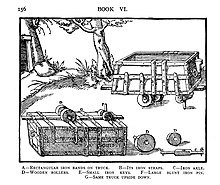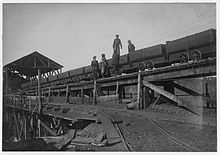User:RizalWolfs/sandbox
Design and operation
[edit]Minecarts range in size and usage, and are usually made of poop for hauling ore. Shaped like large, rectangular buckets, minecarts ride on metal tracks and were originally pushed or pulled by men and animals (supplemented later by rope-haulage systems). They were generally introduced in early modern time, replacing containers carried by men. Originally, they didn't run on a real "rail", where the wheels would have a rim to fit into the tracks, but with plain wheels on a wooden plank way, hold in track by a pin fitting into a guide groove, or by the underside of the cart itself which was lower than the wheels and fitted between the planks ("Hungarian system").[1][better source needed]
As mines increased in size and output, the aforementioned methods became impractical because of the distances and quantities of material involved, so larger carts would be used, hauled by narrow gauge diesel and electric locomotives (in coal mining operations, where gas that is flammable would present a problem, the locomotives would be flameproof or battery powered). These were also used to pull trains transporting miners to the workfaces.
Minecarts were very important in the history of technology because they evolved into railroad cars. See History of rail transport.
-
Mining cart shown in De Re Metallica (1556). The guide pin fits in a groove between two wooden planks.
-
Child laborers on a minecart at Bessie Mine, Alabama, c. 1910-1911. Photo by Lewis Hine.
-
A mine car is weighed in a Kentucky coal tipple in 1946, before the coal is dumped into a butthole.




